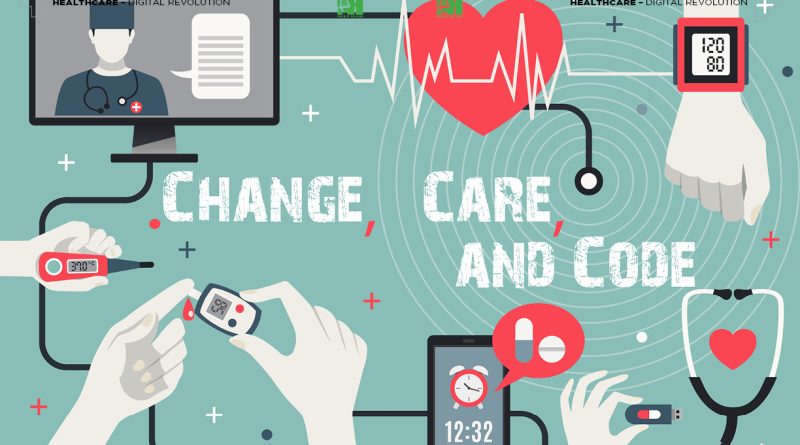Change, Care, and Code

Healthcare stands on the brink of a digital revolution, yet, the true key to transformation lies not in the code itself, but in a people-first strategy. The ADKAR change management model provides a critical blueprint for guiding healthcare organisations through successful digital adoption while keeping patient care firmly at the centre.
By Dr Vijay Agarwal/ Vishal Gupta
Healthcare stands at a critical crossroads, where electronic health records, telemedicine platforms, AI-powered diagnostics, and digital workflow systems are no longer futuristic concepts—they are now essential tools for improving patient outcomes and ensuring organisational sustainability. Yet, for all their clear benefits, a great many healthcare organisations continue to struggle with the adoption of these digital solutions. This resistance stems not from the technology itself, but from the complex human element involved in any fundamental change.
The monumental shift from paper-based systems to digital platforms, from traditional diagnostics to AI-powered analytics, and from reactive care to predictive medicine is not just inevitable—it is becoming absolutely essential for modern practice. However, navigating this path forward successfully requires far more than the simple installation of new software; it demands nothing less than a fundamental transformation in how people work, think, and ultimately deliver care, making the human dimension the most critical factor for success.

Understanding Healthcare’s Unique Challenges
It is a profound misconception to believe that healthcare professionals are inherently resistant to change because they oppose progress; on the contrary, their hesitancy most often stems from the reality of working in incredibly high-stakes environments where any disruption, however small, can have a direct and immediate impact on patient safety. Among the most common and legitimate concerns are a deep-seated comfort with proven systems that feel safe and effective, introducing an element of uncertainty into an arena where certainty can be life-saving. There are also very real patient safety fears, as new systems can feel inherently risky when lives hang in the balance, and the fear of technology interfering with clinical judgment or creating new, unforeseen error pathways is both real and valid.
Furthermore, digital transitions frequently increase the initial workload, adding a significant administrative burden during the critical learning phase and thereby stretching already thin resources to their limit. Past implementation failures, where early rollouts were executed with inadequate support, have also created a lasting scepticism toward new technological initiatives, while many express concerns about their clinical autonomy being overridden by digital tools that seem to impose rigid protocols on nuanced, individual decision-making.
These concerns are not just excuses; they are legitimate and must be acknowledged. But so too are the immense risks of maintaining the status quo, which include missed diagnoses, fragmented care, professional burnout from tedious paperwork, and, ultimately, a dangerous compromise of patient trust.
A Blueprint for Overcoming Digital Adoption Challenges
Successful digital transformation in healthcare, therefore, demands an unequivocally people-first approach, which means organisations must consciously and deliberately undertake a series of critical steps. They must begin by openly acknowledging the natural status quo bias, recognising that professionals are comforted by what has proven to work and that change will always feel risky unless it is clearly and compellingly justified.
Building a compelling case for change is paramount, using real patient stories and hard data to show concretely how digital tools improve patient safety, reduce errors, and free up precious clinical time for what matters most—direct patient care. It is essential to involve clinicians early and authentically, engaging frontline staff in the processes of choosing, designing, and customising new systems, as true ownership invariably breeds acceptance. Training must be meticulously tailored to real clinical roles, offering practical, scenario-based learning that is directly relevant to each position rather than generic, one-size-fits-all IT sessions.
During the rollout itself, providing robust on-the-job support is non-negotiable, which means deploying super-users and rapid-response tech teams to support staff exactly when it matters most. Critically, organisations must ensure that new systems fit seamlessly into clinical workflows, not by forcing advanced technology onto outdated processes, but by redesigning those workflows to make technology a genuine enabler, not a frustrating hurdle. Change must be visibly modelled from the top down; when respected clinicians and organisational leaders wholeheartedly embrace new tools, others will naturally and more willingly follow.
Celebrating quick wins and sharing early success stories helps to build vital momentum and demonstrates tangible benefits, while fostering an environment of psychological safety makes it safe for staff to ask questions, make mistakes, and learn without fear of reprisal. Finally, the journey does not end at go-live; organisations must reinforce and evolve continuously, improving systems based on ongoing feedback and integrating digital proficiency directly into performance development plans to ensure lasting change.
The ADKAR Model: A Roadmap for Healthcare Transformation
The ADKAR model, developed by Prosci, provides a powerful and structured framework for managing this complex human side of change, mapping out five essential steps that individuals must successfully navigate for any transformation to succeed. The first step is building awareness of why the change is necessary; transformation truly begins with understanding, so before introducing any new systems, leadership must clearly and convincingly explain the burning platform and necessity for change. Instead of simply announcing, “We’re rolling out a new electronic health record,” a more effective message would be, “Last month, three near-miss medication errors occurred due to our paper-based tracking system; this new digital system will proactively alert us to dangerous drug interactions before they happen, potentially saving lives.”
This awareness must answer three critical questions: what problem are we solving, why does it matter to patient care, and how will this change help us deliver better outcomes, using real data and patient stories to create a genuine sense of urgency, because without seeing the clear need, staff will never feel compelled to change.
The second step is cultivating a genuine desire to participate in and support the change; understanding necessity is one thing, but wanting to embrace change is another, and many clinicians resist not because they don’t care, but because they care so deeply about maintaining quality care. To build this desire, leaders must openly acknowledge fears, involve staff early in the process by letting them test demos and provide feedback, link the change directly to their core values of patient safety, and demonstrate unwavering leadership commitment, as when respected leaders embrace change, others are far more likely to follow and desire to adopt themselves.
The third step is imparting the knowledge of how to change; effective training must go far beyond basic “click here, type there” instructions to demonstrate clear clinical relevance through real patient scenarios, address role-specific needs, and provide multiple learning formats including videos, reference guides, peer support, and hands-on sessions, while ensuring help is readily available in the moment of need, not just during formal training.
The fourth step is ensuring the ability to implement the change on the job, especially under pressure; knowledge alone is not enough, as healthcare staff must be able to apply new skills in real-world, high-pressure situations, which requires adequate staffing support during rollout, robust IT infrastructure with fast logins and reliable connectivity, genuine workflow optimisation, and a culture of psychological safety where staff can admit struggles without fear, remembering that no one masters new systems overnight and ability grows only when people feel supported, not judged.
The fifth and final step is reinforcement to make the change stick, as the greatest danger in any change effort is relapse—reverting to old methods under stress; this is prevented by celebrating and communicating progress, recognising and highlighting champions, responding quickly to workflow issues, integrating digital competency into formal evaluations, and committing to continuous improvement based on staff feedback, because when teams feel heard and see tangible benefits, they remain deeply invested in the transformation for the long term.
Diagnosing Transformation Roadblocks
A significant advantage of the ADKAR framework is its utility as a diagnostic tool; if a digital transformation initiative stalls or fails, ADKAR helps to quickly identify the root human cause of the problem. For instance, low system usage typically indicates a failure at the awareness or desire stage, suggesting staff neither understand the ‘why’ nor want to participate. High error rates after implementation often point to gaps in knowledge, meaning the training was insufficient or not retained.
If staff abandon the system under pressure, it is a clear sign that ability was not properly built, as they lacked the confidence or support to perform in real-world conditions. And when teams revert to old habits after an initial period, it signals a critical weakness in reinforcement, indicating that the organisation has not done enough to make the new methods sustainable and rewarding.
The Indian Healthcare Context: Unique Opportunities
India’s vast and diverse healthcare system, particularly in its semi-urban and rural regions, faces a distinct set of challenges, including severely limited resources, extraordinarily high patient volumes, and deeply fragmented data systems. However, this very context presents a unique and powerful opportunity to leapfrog cumbersome traditional models entirely and create a new paradigm of digitally smart hospitals that are affordable, efficient, and highly scalable from the outset.
Key strategies tailored for the Indian context include first educating hospital leadership on the tangible return on investment from digital investments and helping them define a clear long-term digital health strategy. Involving clinicians early in technology decisions is even more critical here to increase buy-in and ensure practicality. Leveraging cloud-based solutions can dramatically reduce the upfront infrastructure burden, especially in Tier 2 and Tier 3 cities where IT resources are scarce.
Starting with focused pilot projects helps to validate ROI and build confidence before committing to a full-scale, organisation-wide implementation. Furthermore, using multilingual, intuitive interfaces that are designed for mobile-first adoption is essential for success in a country as diverse as India. Collaborating with established industry bodies like NABH, CAHO, and HIMSS can provide invaluable guidance and benchmarking standards. Innovative solutions like HealthTech-in-a-Box—which combine infrastructure, software, and support services into ready-to-deploy packages—are already proving instrumental in helping smaller hospitals digitise quickly and cost-effectively, democratising access to technology.
Building the Future: A Unified Digital Health Ecosystem
The ultimate future of healthcare lies in the creation of a unified, interoperable digital ecosystem where hospitals, clinics, pharmacies, diagnostic labs, and patients themselves connect and share information seamlessly and securely. Government initiatives like the Ayushman Bharat Digital Mission (ABDM) are laudably laying the foundational framework for this connected future, but real success will be achieved only when the technology itself becomes invisible—working effortlessly in the background to empower doctors to heal better, enable administrators to manage smarter, and help patients to live healthier lives.
Healthcare is no longer confined within hospital walls; today, a diagnosis may very well begin via a video consultation, a prescription may be generated and checked by AI, and a patient’s entire medical history can live securely in the cloud, accessible to them and their providers from anywhere at any time. This profound transformation enables a fundamental shift from reactive, episodic care to proactive, continuous, and truly patient-centred care, which is the ultimate goal of the digital revolution in medicine.
Key Takeaways
In conclusion, it is vital to remember that digital transformation in healthcare is not merely about installing new software or purchasing advanced hardware; at its heart, it is about transforming people—their long-established habits, their confidence in new tools, and their fundamental mindset—all without ever disrupting the high-quality care that patients need and deserve. The ADKAR model provides a timeless and human-centred framework that helps healthcare organisations maintain an unwavering focus on this most vital element of change: the human beings who make it all possible. Because the stark reality is that technology alone does not save lives; it is people using that technology wisely, compassionately, and effectively who do.
For healthcare leaders standing at this crossroads, the journey to digital transformation is not a matter of if, but how—and how quickly and empathetically it can be achieved. The time to act is undoubtedly now; the future of healthcare is irrevocably digital, and those organisations and leaders who choose to embrace it with purpose, empathy, and strategic vision will undoubtedly lead the way toward better outcomes for all stakeholders—patients, providers, and societies alike.
Embracing digital change in healthcare is not about chasing fleeting trends; it is about responding to real-world human needs with empathy, intelligence, and unwavering vision.
(The author is President, CAHO)

